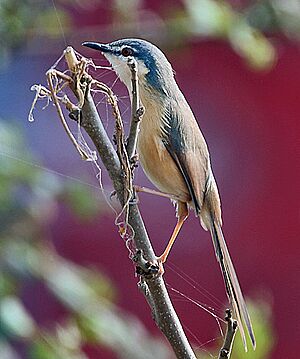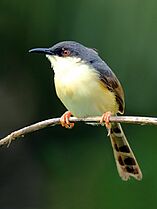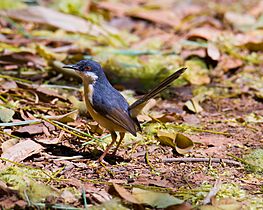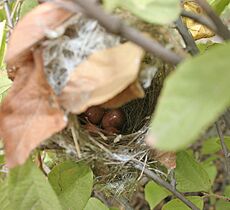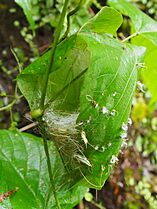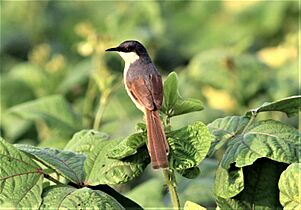Ashy prinia facts for kids
Quick facts for kids Ashy prinia |
|
|---|---|
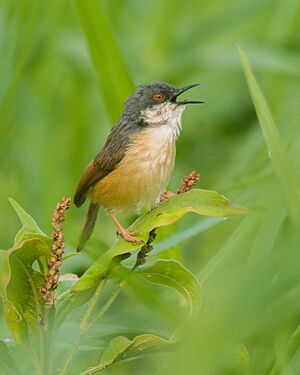 |
|
| Ashy Prinia calling. | |
| Conservation status | |
| Scientific classification | |
| Genus: |
Prinia
|
| Species: |
socialis
|
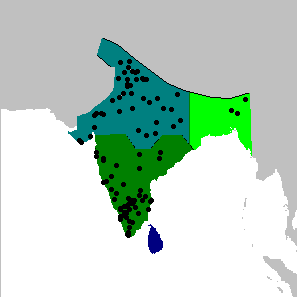 |
|
| Distribution of subspecies of Prinia socialis | |
| Synonyms | |
|
Burnesia socialis |
|
The Ashy Prinia (Prinia socialis) is a small, active bird that lives in the Indian subcontinent. It's also sometimes called the Ashy Wren-Warbler. You can find these birds in many places, from city gardens to farmlands, across countries like India, Nepal, Bangladesh, and Sri Lanka. They are easy to spot because of their small size, unique colors, and how they hold their tail straight up!
Contents
What Does the Ashy Prinia Look Like?
These little birds are about 13–14 centimeters (5-5.5 inches) long. They have short, rounded wings and a long, creamy tail with black spots at the end. The tail is usually held straight up, like a little flag! They have strong legs that help them hop around on the ground and climb through bushes. Their beak is short and black.
Most Ashy Prinias have a grey head and a reddish-brown belly. In the northern parts of their home, adult birds look a bit different during breeding season. They have an ash-grey back, a black head, and coppery-brown wings. When it's not breeding season, these birds get a short, thin white stripe above their eye. Other Ashy Prinias keep the same colors all year. You'll often see them alone or in pairs, exploring shrubs and the ground.
Different Types of Ashy Prinias
There are a few different types, or subspecies, of the Ashy Prinia.
- The northern type, called P. s. stewartii, has warm brown upper parts in winter and a longer tail.
- The type found in West Bengal and further east, called inglisi, is a bit greyer and has a deeper reddish-brown color on its sides.
- The unique type in Sri Lanka, called P. s. brevicauda, has a shorter tail. Young birds of this type have yellowish bellies and a special call.
Where Do Ashy Prinias Live?
This small passerine bird likes dry, open grassy areas, open woodlands, and even gardens in many cities. You can find them from the foothills of the Himalayas down to the upper Indus river system. They don't live in the very dry desert areas of western India. In Sri Lanka, they mostly live in lower areas but can be found up to about 1600 meters (about a mile high) in the hills.
How Do Ashy Prinias Behave?
Like most warblers, Ashy Prinias love to eat insects. They are very active and always looking for their next meal!
Sounds and Songs
Their song is often a repeated sound like tchup, tchup, tchup or zeet-zeet-zeet. They also make a nasal sound that sounds like tee-tee-tee. Sometimes, when they fly, they make a quick snapping sound, almost like "electric sparks"! People think this sound might be made by their wings hitting their tail as they flutter around.
Changing Feathers
Unlike many birds, Ashy Prinias change their feathers twice a year! One time is in spring (April to May), and another time is in autumn (October to November). This is quite unusual for small birds. They usually stay in pairs but sleep alone on a branch of a small tree or bush.
Ashy Prinia Families
Building Nests
When it's time to find a mate, the male Ashy Prinia sings from the top of a bush. He also performs fluttery display flights, holding his tail high. Ashy Prinias build their nests close to the ground in a bush or tall grass. They are very clever nest builders!
- Some nests are simple cups made by stitching together large leaves.
- Others are like oblong purses with grass stems inside.
- The most common nest is built low in a bush. It's made of leaves stitched together with spider webs and lined with soft hair. It has an entrance on the side.
Eggs and Chicks
The female Ashy Prinia lays 3 to 5 shiny, oval-shaped eggs. These eggs can be brick-red to a rich chestnut color. The wider end of the egg is usually darker. The eggs are about 15 to 17 millimeters (0.6-0.7 inches) long and 11 to 13 millimeters (0.4-0.5 inches) wide. The eggs hatch in about 12 days.
Breeding Season
The breeding season changes depending on where the birds live. In northern India, it's usually from June to September, after the monsoon rains. In Sri Lanka, it's mainly from December to March or August to October. In the Nilgiris, it's during May to June. Both the male and female Ashy Prinias help to incubate the eggs and feed the young chicks. Sometimes, other birds like the Plaintive cuckoo or grey-bellied cuckoo might lay their eggs in an Ashy Prinia's nest, letting the prinia raise their chicks. If a predator like a cat comes near the nest, the adult prinias might pretend to be hurt to distract the danger away from their babies.
Gallery
-
Nest with eggs, Hyderabad, India



